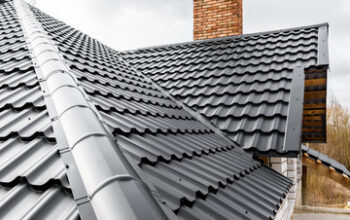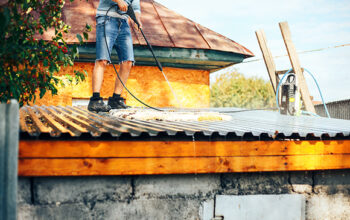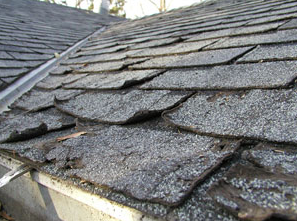When a roof constantly fights the elements, it shouldn’t be burdened by debris. Consistently cleaning away leaves, debris, and other materials will help to prevent clogs and other problems. Detailed inspections of the flashing, skylights, walls, penetrations, equipment curbs, and drains should be done regularly. This allows for early problem detection before leaks develop.
Inspect the Flashing
Roof flashing is a crucial element of the roofing system, preventing water from entering the home through seams and corners. They are typically made of copper, aluminum, or galvanized steel. You should check the flashing regularly, especially around things that protrude from the roof like chimneys, skylights, and vents. It would be best to look for gaps, signs of leakage, and missing caulking.

Often, homeowners don’t realize that their roof is leaking until it starts causing problems inside the house. This can include mold, ruined insulation, rotten wood, and even structural damage to the walls and ceilings. Regular maintenance can prevent these problems and detect leaks early.
Many roofing leaks begin in the flashing, which is why it’s so important to inspect it regularly. This will allow you to repair the flashing before it begins leaking into the home, saving you money and eliminating the need for costly repairs.
Inspecting the flashing can be done by walking on the roof, by a ladder at the eaves or from a window above. However, if you don’t feel comfortable walking on the roof or it would be unsafe to do so, a professional should be hired to evaluate the condition of the roof.
If you notice that the flashing is damaged, it may be time to replace it. You can do this yourself if the damage is minimal, but you’ll need to remove shingles that surround or cover the flashing, as well as the old caulking.
You can reseal the flashing with new caulking or metal roofing cement, which is available in a variety of colors to match your existing roof. When you do this, make sure that the flashing is thoroughly cleaned to avoid causing further damage.
If you notice rust on the metal flashing, it’s probably due for replacement. The rust can cause additional damage to the metal and could lead to a leak in the future. If the rust is widespread, it’s likely best to just replace all of the flashing on your roof. A roofing contractor can help you find the right type of flashing for your home and install it properly to prevent leaks.
Inspect the Shingles
Your home’s roof is covered with shingles that protect the house from rain, snow, and hail. It’s important to inspect the shingles for damage and wear, especially after a major storm. The best way to do this is from the ground, by walking around your property and observing the roof. You’ll notice if it is sagging or damaged, as well as if there are shingle granules down in the gutters.
The shingles should be straight, secure and free of stains. If they’re brittle or cracked, they should be replaced. The roof inspector will also look for moss, mildew and mold growth. These can not only be unsightly, but they can cause the shingles to become brittle and vulnerable to moisture penetration. They need moisture to thrive, so they trap the water on your roof’s surface and create raised masses that hinder water runoff, which causes additional problems.
A home inspector will check all the roof flashing, which is metal placed wherever shingles butt up against something like a wall, chimney or vent pipe. They will ensure it isn’t rusted and that it is secure and able to keep out the elements, keeping your home safe from leaks. They will also check the rubber boots and seals of the vent pipes, looking for gaps that could allow moisture in and rot the wood underneath the shingles.
You should also look for shingle damage, which can lead to leaks or even complete roof failure. Loose shingles can be blown off during high winds, which can leave your roof exposed and vulnerable to storm damage and insect infestation. You can tell if a shingle is loose by gently trying to pull it up from the bottom, being careful not to damage it. Cracked or split shingles should be replaced, as should shingles that are missing or worn down, curling, buckling or blistering.
If you see any of these signs, schedule an appointment with a roofing contractor as soon as possible to repair the problem and prevent further damage to your roof and your home. The unpredictability of mother nature means that any damage done to your roof can escalate quickly, so it’s best to be proactive and have any issues taken care of as soon as you notice them.
Inspect the Gutters
Guttering is a necessary part of a roof system that captures and directs water runoff away from the structure. A clogged gutter can cause puddling on the roof or lead to leaks and structural damage. Home inspectors should instruct their clients to regularly clean out and inspect their gutters. This can be done with a ladder and a hose or by hiring a professional gutter cleaning service. It is important to check that gutter downspouts are properly diverting water 4 to 6 feet away from the foundation of the house.
A sagging gutter is another sign that it’s time to replace it. When the gutters aren’t draining properly, they can cause moisture intrusion into the soffit and fascia boards or leak into the interior of the home. This can lead to wood rot, mold and mildew which may require expensive repairs.
When inspecting the gutters, a professional will look for signs of clogging, dents, cracks and downspouts that aren’t properly channeling water away from the house. They will also take note of rust on gutter metal and look for any areas where the rafter hangers or spikes have pulled away from the wood framing.
Gutters that pull away from the house can cause wood rot and create a pathway for water intrusion into the attic or basement of the building. This can lead to mold, mildew and other moisture problems.
In addition to checking the condition of the shingles and flashing, a home inspector should also examine the gutters for proper drainage, clogging, and rust. They should also recommend any necessary maintenance such as removing moss, re-caulking the roof valleys and replacing missing or damaged shingle trim pieces.
A roof inspection can be a daunting task for the average homeowner to perform. However, if performed and recorded on a regular basis, it can help homeowners catch problems before they cause significant and costly damage. Performing this maintenance can also ensure that the home’s value remains high. This is especially important for homeowners who are considering selling their property in the future. An inspection can help them get the most money for their home.
Trim Trees
Trees add beauty and ambiance to yards, and they also help shield houses from high winds. However, they may damage a roof if their limbs and branches come too close to the house. This is why homeowners should hire a tree trimming company to perform regular maintenance on their yard’s trees.
Branches that overhang the roof are not just a nuisance because they scratch against it when wind blows; they can also do significant damage to shingles and other roofing materials in the event of a storm. In addition, they can cause the accumulation of organic debris on the roof and gutters. This material traps moisture and can lead to the formation of rot, which can also damage roofs and other structures in the area.
In addition, twigs and other debris can be pulled by the wind to a height that may threaten the safety of those in the home or structure. This can be a significant problem for older homes that may not have protective barriers in place.
While some people attempt to trim their own limbs, this can be a dangerous task and should not be taken lightly. Inexperienced or improper trimming can damage the structure, and it could even be fatal. Professional arborists are trained to handle this delicate work. They are also insured, which protects the homeowner in case something goes wrong and damages the property.
It is also important to keep in mind that not all types of trees can be planted near a roof. For example, walnut, hickory, pecan and sweet gum trees can be especially damaging to roofs. They produce large nuts and a sticky sap that may damage shingles, gutters, fascia boards and other components of the house.
A yearly inspection of the roof and the surrounding landscape should include a thorough examination of all trees for proper trims and removal. If you are concerned about your trees, contact a professional tree service today to schedule an inspection and trimming of the overhanging branches. Taking this measure is essential to the health and longevity of your roof.



